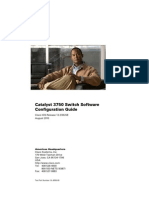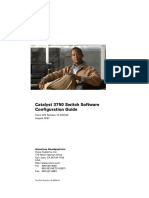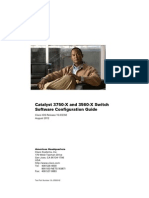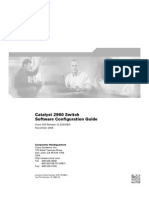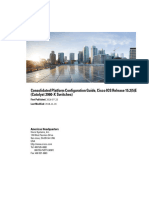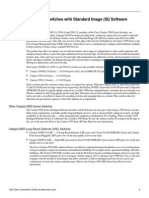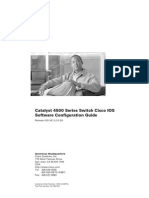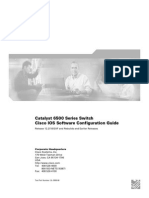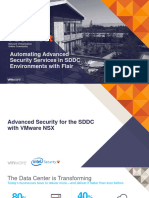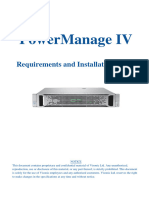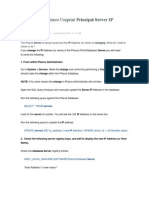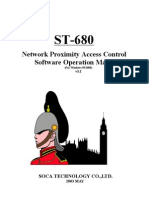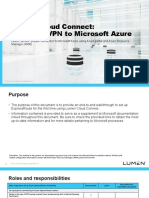Siwtch Introduction
Uploaded by
Khoi TranSiwtch Introduction
Uploaded by
Khoi TranCH A P T E R 1
Overview
This chapter provides these topics about the Catalyst 3750 switch software:
• Features, page 1-1
• Default Settings After Initial Switch Configuration, page 1-16
• Network Configuration Examples, page 1-18
• Where to Go Next, page 1-28
Unless otherwise noted, the term switch refers to a standalone switch and to a switch stack.
In this document, IP refers to IP Version 4 (IPv4) unless there is a specific reference to IP Version 6
(IPv6).
Features
The switch ships with one of these software images installed:
• IP base image, which provides Layer 2+ features (enterprise-class intelligent services). These
features include access control lists (ACLs), quality of service (QoS), static routing, EIGRP stub
routing, PIM stub routing, the Hot Standby Router Protocol (HSRP), and the Routing Information
Protocol (RIP). Switches with the IP base image installed can be upgraded to IP services image.
• IP services image, which provides a richer set of enterprise-class intelligent services. It includes all
IP base image features plus full Layer 3 routing (IP unicast routing, IP multicast routing, and
fallback bridging). To distinguish it from the Layer 2+ static routing and RIP, the IP services image
includes protocols such as the Enhanced Interior Gateway Routing Protocol (EIGRP) and the Open
Shortest Path First (OSPF) Protocol.
IP services image-only Layer 3 features are described in the “Layer 3 Features” section on
page 1-13.
Note Unless otherwise noted, all features described in this chapter and in this guide are supported on
both the IP base image and IP services image.
IPv6 Multicast Listener Discovery (MLD) snooping is supported in all Catalyst 3560 and 3750 images;
for more information, see Chapter 40, “Configuring IPv6 MLD Snooping.”
For full IPv6 support, the IP services image is required. For more information on IPv6 routing, see
Chapter 39, “Configuring IPv6 Unicast Routing.”
For more information on IPv6 ACLs, see Chapter 41, “Configuring IPv6 ACLs.”
Catalyst 3750 Switch Software Configuration Guide
OL-8550-08 1-1
Chapter 1 Overview
Features
Some features described in this chapter are available only on the cryptographic (supports encryption)
version of the software. You must obtain authorization to use this feature and to download the
cryptographic version of the software from Cisco.com. For more information, see the release notes for
this release.
• Ease-of-Deployment and Ease-of-Use Features, page 1-2
• Performance Features, page 1-4
• Management Options, page 1-5
• Manageability Features, page 1-6
• Availability and Redundancy Features, page 1-7
• VLAN Features, page 1-9
• Security Features, page 1-9
• QoS and CoS Features, page 1-12
• Layer 3 Features, page 1-13 (includes features requiring the IP services image)
• Power over Ethernet Features, page 1-15
• Monitoring Features, page 1-15
Ease-of-Deployment and Ease-of-Use Features
• Express Setup for quickly configuring a switch for the first time with basic IP information, contact
information, switch and Telnet passwords, and Simple Network Management Protocol (SNMP)
information through a browser-based program. For more information about Express Setup, see the
getting started guide.
• User-defined and Cisco-default Smartports macros for creating custom switch configurations for
simplified deployment across the network.
• An embedded device manager GUI for configuring and monitoring a single switch through a web
browser. For information about launching the device manager, see the getting started guide. For more
information about the device manager, see the switch online help.
• Cisco Network Assistant (hereafter referred to as Network Assistant) for
– Managing communities, which are device groups like clusters, except that they can contain
routers and access points and can be made more secure.
– Simplifying and minimizing switch, switch stack, and switch cluster management from
anywhere in your intranet.
– Accomplishing multiple configuration tasks from a single graphical interface without needing
to remember command-line interface (CLI) commands to accomplish specific tasks.
– Interactive guide mode that guides you in configuring complex features such as VLANs, ACLs,
and quality of service (QoS).
– Configuration wizards that prompt you to provide only the minimum required information to
configure complex features such as QoS priorities for traffic, priority levels for data
applications, and security.
– Downloading an image to a switch.
– Applying actions to multiple ports and multiple switches at the same time, such as VLAN and
QoS settings, inventory and statistic reports, link- and switch-level monitoring and
troubleshooting, and multiple switch software upgrades.
Catalyst 3750 Switch Software Configuration Guide
1-2 OL-8550-08
Chapter 1 Overview
Features
– Viewing a topology of interconnected devices to identify existing switch clusters and eligible
switches that can join a cluster and to identify link information between switches.
– Monitoring real-time status of a switch or multiple switches from the LEDs on the front-panel
images. The system, redundant power system (RPS), and port LED colors on the images are
similar to those used on the physical LEDs.
Note The Network Assistant must be downloaded from cisco.com/go/cna.
• Cisco StackWise technology for
– Connecting up to nine switches through their StackWise ports and operating as a single switch
or switch-router in the network.
– Creating a bidirectional 32-Gb/s switching fabric across the switch stack, where all stack
members have full access to the system bandwidth.
– Using a single IP address and configuration file to manage the entire switch stack.
– Automatic Cisco IOS version-check of new stack members with the option to automatically load
images from the stack master or from a TFTP server.
– Adding, removing, and replacing switches in the stack without disrupting the operation of the
stack.
– Provisioning a new member for a switch stack with the offline configuration feature. You can
configure in advance the interface configuration for a specific stack member number and for a
specific switch type of a new switch that is not part of the stack. The switch stack retains this
information across stack reloads whether or not the provisioned switch is part of the stack.
– Displaying stack-ring activity statistics (the number of frames sent by each stack member to the
ring).
• Switch clustering technology for
– Unified configuration, monitoring, authentication, and software upgrade of multiple,
cluster-capable switches, regardless of their geographic proximity and interconnection media,
including Ethernet, Fast Ethernet, Fast EtherChannel, small form-factor pluggable (SFP)
modules, Gigabit Ethernet, and Gigabit EtherChannel connections. For a list of cluster-capable
switches, see the release notes.
– Automatic discovery of candidate switches and creation of clusters of up to 16 switches that can
be managed through a single IP address.
– Extended discovery of cluster candidates that are not directly connected to the command switch.
• Stack Troubleshooting Enhancements
• Auto Smartports Cisco-default and user-defined macros for dynamic port configuration based on the
device type detected on the port.
• Smart Install to allow a single point of management (director) in a network. You can use Smart
Install to provide zero touch image and configuration upgrade of newly deployed switches and
image and configuration downloads for any client switches. For more information, see the Cisco
Smart Install Configuration Guide.
• AutoSmartPort enhancements, which adds support for macro persistency, LLDP-based triggers,
MAC address and OUI-based triggers, remote macros as well as for automatic configuration based
on these two new device types: Cisco Digital Media Player (Cisco DMP) and Cisco IP Video
Surveillance Camera (Cisco IPVSC).
Catalyst 3750 Switch Software Configuration Guide
OL-8550-08 1-3
Chapter 1 Overview
Features
Performance Features
• Cisco EnergyWise manages the energy usage of power over Ethernet (PoE) entities.
For more information, see the Cisco EnergyWise Version 2 Configuration Guide on Cisco.com.
• Autosensing of port speed and autonegotiation of duplex mode on all switch ports for optimizing
bandwidth
• Automatic-medium-dependent interface crossover (auto-MDIX) capability on 10/100 and
10/100/1000 Mb/s interfaces and on 10/100/1000 BASE-TX SFP module interfaces that enables the
interface to automatically detect the required cable connection type (straight-through or crossover)
and to configure the connection appropriately
• Support for up to 1546 bytes routed frames, up to 9000 bytes for frames that are bridged in hardware,
and up to 2000 bytes for frames that are bridged by software
• IEEE 802.3x flow control on all ports (the switch does not send pause frames)
• Up to 32 Gb/s of forwarding rates in a switch stack
• EtherChannel for enhanced fault tolerance and for providing up to 8 Gb/s (Gigabit EtherChannel)
or 800 Mb/s (Fast EtherChannel) full-duplex bandwidth among switches, routers, and servers
• Port Aggregation Protocol (PAgP) and Link Aggregation Control Protocol (LACP) for automatic
creation of EtherChannel links
• Forwarding of Layer 2 and Layer 3 packets at Gigabit line rate across the switches in the stack
• Multicast virtual routing and forwarding (VRF) Lite for configuring multiple private routing
domains for network virtualization and virtual private multicast networks
• Per-port storm control for preventing broadcast, multicast, and unicast storms
• Port blocking on forwarding unknown Layer 2 unknown unicast, multicast, and bridged broadcast
traffic
• Cisco Group Management Protocol (CGMP) server support and Internet Group Management
Protocol (IGMP) snooping for IGMP Versions 1, 2, and 3:
– (For CGMP devices) CGMP for limiting multicast traffic to specified end stations and reducing
overall network traffic
– (For IGMP devices) IGMP snooping for forwarding multimedia and multicast traffic
• IGMP report suppression for sending only one IGMP report per multicast router query to the
multicast devices (supported only for IGMPv1 or IGMPv2 queries)
• IGMP snooping querier support to configure switch to generate periodic IGMP general query
messages
• IGMP helper to allow the switch to forward a host request to join a multicast stream to a specific IP
destination address
• Multicast VLAN registration (MVR) to continuously send multicast streams in a multicast VLAN
while isolating the streams from subscriber VLANs for bandwidth and security reasons
• IGMP filtering for controlling the set of multicast groups to which hosts on a switch port can belong
• IGMP throttling for configuring the action when the maximum number of entries is in the IGMP
forwarding table
• IGMP leave timer for configuring the leave latency for the network
• Switch Database Management (SDM) templates for allocating system resources to maximize
support for user-selected features
Catalyst 3750 Switch Software Configuration Guide
1-4 OL-8550-08
Chapter 1 Overview
Features
• Web Cache Communication Protocol (WCCP) for redirecting traffic to local wide-area application
engines, for enabling content requests to be fulfilled locally, and for localizing web-traffic patterns
in the network (requires the IP services image)
• Cisco IOS IP Service Level Agreements (SLAs), a part of Cisco IOS software that uses active traffic
monitoring for measuring network performance.
• Configurable small-frame arrival threshold to prevent storm control when small frames (64 bytes or
less) arrive on an interface at a specified rate (the threshold)
• Flex Link Multicast Fast Convergence to reduce the multicast traffic convergence time after a Flex
Link failure
• RADIUS server load balancing to allow access and authentication requests to be distributed evenly
across a server group.
• Cisco Medianet to enable intelligent services in the network infrastructure for a wide variety of
video applications. One of the services of Medianet is auto provisioning for Cisco Digital Media
Players and Cisco IP Video Surveillance cameras through Auto Smartports.
• Support for QoS marking of CPU-generated traffic and queue CPU-generated traffic on the egress
network ports.
Management Options
• An embedded device manager—The device manager is a GUI that is integrated in the software
image. You use it to configure and to monitor a single switch. For information about launching the
device manager, see the getting started guide. For more information about the device manager, see the
switch online help.
• Network Assistant—Network Assistant is a network management application that can be
downloaded from Cisco.com. You use it to manage a single switch, a cluster of switches, or a
community of devices. For more information about Network Assistant, see Getting Started with
Cisco Network Assistant, available on Cisco.com.
• CLI—The Cisco IOS software supports desktop- and multilayer-switching features. You can access
the CLI either by connecting your management station directly to the switch console port or by using
Telnet from a remote management station. You can manage the switch stack by connecting to the
console port of any stack member. For more information about the CLI, see Chapter 2, “Using the
Command-Line Interface.”
• SNMP—SNMP management applications such as CiscoWorks2000 LAN Management Suite (LMS)
and HP OpenView. You can manage from an SNMP-compatible management station that is running
platforms such as HP OpenView or SunNet Manager. The switch supports a comprehensive set of
MIB extensions and four remote monitoring (RMON) groups. For more information about using
SNMP, see Chapter 33, “Configuring SNMP.”
• Cisco IOS Configuration Engine (previously known to as the Cisco IOS CNS
agent)-—Configuration service automates the deployment and management of network devices and
services. You can automate initial configurations and configuration updates by generating
switch-specific configuration changes, sending them to the switch, executing the configuration
change, and logging the results.
For more information about CNS, see Chapter 4, “Configuring Cisco IOS Configuration Engine.”
Catalyst 3750 Switch Software Configuration Guide
OL-8550-08 1-5
Chapter 1 Overview
Features
Manageability Features
• CNS embedded agents for automating switch management, configuration storage, and delivery
• DHCP for automating configuration of switch information (such as IP address, default gateway,
hostname, and Domain Name System [DNS] and TFTP server names)
• DHCP relay for forwarding User Datagram Protocol (UDP) broadcasts, including IP address
requests, from DHCP clients
• DHCP server for automatic assignment of IP addresses and other DHCP options to IP hosts
• DHCP-based autoconfiguration and image update to download a specified configuration a new
image to a large number of switches
• DHCP server port-based address allocation for the preassignment of an IP address to a switch port
• Directed unicast requests to a DNS server for identifying a switch through its IP address and its
corresponding hostname and to a TFTP server for administering software upgrades from a TFTP
server
• Address Resolution Protocol (ARP) for identifying a switch through its IP address and its
corresponding MAC address
• Unicast MAC address filtering to drop packets with specific source or destination MAC addresses
• Configurable MAC address scaling that allows disabling MAC address learning on a VLAN to limit
the size of the MAC address table
• Cisco Discovery Protocol (CDP) Versions 1 and 2 for network topology discovery and mapping
between the switch and other Cisco devices on the network
• Link Layer Discovery Protocol (LLDP) and LLDP Media Endpoint Discovery (LLDP-MED) for
interoperability with third-party IP phones
• LLDP media extensions (LLDP-MED) location TLV that provides location information from the
switch to the endpoint device
• Network Time Protocol (NTP) for providing a consistent time stamp to all switches from an external
source
• Cisco IOS File System (IFS) for providing a single interface to all file systems that the switch uses
• Support for the SSM PIM protocol to optimize multicast applications, such as video
• Source Specific Multicast (SSM) mapping for multicast applications provides a mapping of source
to group, allowing listeners to connect to multicast sources dynamically and reduces dependencies
on the application
• Support for Enhanced Interior Gateway Routing Protocol (EIGRP) IPv6 to utilize IPv6 transport,
communicate with IPv6 peers, and advertise IPv6 routes
• Support for these IP services, making them VRF aware so that they can operate on multiple routing
instances: HSRP, ARP, SNMP, IP SLA, TFTP, FTP, syslog, traceroute, and ping
• Configuration logging to log and to view changes to the switch configuration
• Unique device identifier to provide product identification information through a show inventory
user EXEC command display
• In-band management access through the device manager over a Netscape Navigator or Microsoft
Internet Explorer browser session
• In-band management access for up to 16 simultaneous Telnet connections for multiple CLI-based
sessions over the network
Catalyst 3750 Switch Software Configuration Guide
1-6 OL-8550-08
Chapter 1 Overview
Features
• In-band management access for up to five simultaneous, encrypted Secure Shell (SSH) connections
for multiple CLI-based sessions over the network
• In-band management access through SNMP Versions 1, 2c, and 3 get and set requests
• Out-of-band management access through the switch console port to a directly attached terminal or
to a remote terminal through a serial connection or a modem
• Secure Copy Protocol (SCP) feature to provide a secure and authenticated method for copying
switch configuration or switch image files (requires the cryptographic version of the software)
• Configuration replacement and rollback to replace the running configuration on a switch with any
saved Cisco IOS configuration file
• On the Catalyst 3750G Integrated Wireless LAN Controller Switch only, an integrated
Catalyst 3750 switch and Cisco 4400 series wireless LAN controller that supports up to 25 or 50
lightweight access points
• The HTTP client in Cisco IOS supports can send requests to both IPv4 and IPv6 HTTP server, and
the HTTP server in Cisco IOS can service HTTP requests from both IPv4 and IPv6 HTTP clients
• Simple Network and Management Protocol (SNMP) can be configured over IPv6 transport so that
an IPv6 host can send SNMP queries and receive SNMP notifications from a device running IPv6
• IPv6 stateless autoconfiguration to manage link, subnet, and site addressing changes, such as
management of host and mobile IP addresses
• Disabling MAC address learning on a VLAN
• DHCP server port-based address allocation for the preassignment of an IP address to a switch port.
• Wired location service sends location and attachment tracking information for connected devices to
a Cisco Mobility Services Engine (MSE).
• CPU utilization threshold trap monitors CPU utilization.
• LLDP-MED network-policy profile time, length, value (TLV) for creating a profile for voice and
voice-signalling by specifying the values for VLAN, class of service (CoS), differentiated services
code point (DSCP), and tagging mode.
• Support for including a hostname in the option 12 field of DHCPDISCOVER packets. This provides
identical configuration files to be sent by using the DHCP protocol.
• DHCP Snooping enhancement to support the selection of a fixed string-based format for the
circuit-id sub-option of the Option 82 DHCP field.
• Increased support for LLPD-MED by allowing the switch to grant power to the power device (PD),
based on the power policy TLV request.
• Cisco EnergyWise to manage the power usage of EnergyWise entities, such as power over Ethernet
(PoE) devices and end points running daemons.
Availability and Redundancy Features
• HSRP for command switch and Layer 3 router redundancy
• Enhanced object tracking, which separates the tracking mechanism from HSRP and creates a
separate, standalone tracking process that can be used by processes other than HSRP
• Automatic stack master re-election for replacing stack masters that become unavailable (failover
support)
Catalyst 3750 Switch Software Configuration Guide
OL-8550-08 1-7
Chapter 1 Overview
Features
The newly elected stack master begins accepting Layer 2 traffic in less than 1 second and Layer 3
traffic between 3 to 5 seconds.
• Cross-stack EtherChannel for providing redundant links across the switch stack
• UniDirectional Link Detection (UDLD) and aggressive UDLD for detecting and disabling
unidirectional links on fiber-optic interfaces caused by incorrect fiber-optic wiring or port faults
• IEEE 802.1D Spanning Tree Protocol (STP) for redundant backbone connections and loop-free
networks. STP has these features:
– Up to 128 spanning-tree instances supported
– Per-VLAN spanning-tree plus (PVST+) for load balancing across VLANs
– Rapid PVST+ for load balancing across VLANs and providing rapid convergence of
spanning-tree instances
– UplinkFast, cross-stack UplinkFast, and BackboneFast for fast convergence after a
spanning-tree topology change and for achieving load balancing between redundant uplinks,
including Gigabit uplinks and cross-stack Gigabit uplinks
• IEEE 802.1s Multiple Spanning Tree Protocol (MSTP) for grouping VLANs into a spanning-tree
instance and for providing multiple forwarding paths for data traffic and load balancing and rapid
per-VLAN Spanning-Tree plus (rapid-PVST+) based on the IEEE 802.1w Rapid Spanning Tree
Protocol (RSTP) for rapid convergence of the spanning tree by immediately changing root and
designated ports to the forwarding state
• Optional spanning-tree features available in PVST+, rapid-PVST+, and MSTP mode:
– Port Fast for eliminating the forwarding delay by enabling a port to immediately change from
the blocking state to the forwarding state
– BPDU guard for shutting down Port Fast-enabled ports that receive bridge protocol data units
(BPDUs)
– BPDU filtering for preventing a Port Fast-enabled port from sending or receiving BPDUs
– Root guard for preventing switches outside the network core from becoming the spanning-tree
root
– Loop guard for preventing alternate or root ports from becoming designated ports because of a
failure that leads to a unidirectional link
• Equal-cost routing for link-level and switch-level redundancy
• Flex Link Layer 2 interfaces to back up one another as an alternative to STP for basic link
redundancy
• Link-state tracking to mirror the state of the ports that carry upstream traffic from connected hosts
and servers, and to allow the failover of the server traffic to an operational link on another Cisco
Ethernet switch.
• RPS support through the Cisco Redundant Power System 2300, also referred to as the RPS 2300,
for enhancing power reliability, configuring and managing the redundant power system. For more
information about the RPS 2300, see the Cisco Redundant Power System 2300 Hardware
Installation Guide that shipped with the device and that is also on Cisco.com.
Catalyst 3750 Switch Software Configuration Guide
1-8 OL-8550-08
Chapter 1 Overview
Features
VLAN Features
• Support for up to 1005 VLANs for assigning users to VLANs associated with appropriate network
resources, traffic patterns, and bandwidth
• Support for VLAN IDs in the 1 to 4094 range as allowed by the IEEE 802.1Q standard
• VLAN Query Protocol (VQP) for dynamic VLAN membership
• Inter-Switch Link (ISL) and IEEE 802.1Q trunking encapsulation on all ports for network moves,
adds, and changes; management and control of broadcast and multicast traffic; and network security
by establishing VLAN groups for high-security users and network resources
• Dynamic Trunking Protocol (DTP) for negotiating trunking on a link between two devices and for
negotiating the type of trunking encapsulation (IEEE 802.1Q or ISL) to be used
• VLAN Trunking Protocol (VTP) and VTP pruning for reducing network traffic by restricting
flooded traffic to links destined for stations receiving the traffic
• Voice VLAN for creating subnets for voice traffic from Cisco IP Phones
• VLAN 1 minimization for reducing the risk of spanning-tree loops or storms by allowing VLAN 1
to be disabled on any individual VLAN trunk link. With this feature enabled, no user traffic is sent
or received on the trunk. The switch CPU continues to send and receive control protocol frames.
• Private VLANs to address VLAN scalability problems, to provide a more controlled IP address
allocation, and to allow Layer 2 ports to be isolated from other ports on the switch
• Port security on a PVLAN host to limit the number of MAC addresses learned on a port, or define
which MAC addresses may be learned on a port
• VLAN Flex Link Load Balancing to provide Layer 2 redundancy without requiring Spanning Tree
Protocol (STP). A pair of interfaces configured as primary and backup links can load balance traffic
based on VLAN.
• Support for 802.1x authentication with restricted VLANs (also known as authentication failed
VLANs).
• Support for VTP version 3 that includes support for configuring extended range VLANs (VLANs
1006 to 4094) in any VTP mode, enhanced authentication (hidden or secret passwords), propagation
of other databases in addition to VTP, VTP primary and secondary servers, and the option to turn
VTP on or off by port.
Security Features
• IP Service Level Agreements (IP SLAs) support to measure network performance by using active
traffic monitoring
• IP SLAs EOT to use the output from IP SLAs tracking operations triggered by an action such as
latency, jitter, or packet loss for a standby router failover takeover
• Web authentication to allow a supplicant (client) that does not support IEEE 802.1x functionality to
be authenticated using a web browser
• Local web authentication banner so that a custom banner or an image file can be displayed at a web
authentication login screen
• MAC authentication bypass (MAB) aging timer to detect inactive hosts that have authenticated after
they have authenticated by using MAB
Catalyst 3750 Switch Software Configuration Guide
OL-8550-08 1-9
Chapter 1 Overview
Features
• Password-protected access (read-only and read-write access) to management interfaces (device
manager, Network Assistant, and the CLI) for protection against unauthorized configuration
changes
• Multilevel security for a choice of security level, notification, and resulting actions
• Static MAC addressing for ensuring security
• Protected port option for restricting the forwarding of traffic to designated ports on the same switch
• Port security option for limiting and identifying MAC addresses of the stations allowed to access
the port
• VLAN aware port security option to shut down the VLAN on the port when a violation occurs,
instead of shutting down the entire port.
• Port security aging to set the aging time for secure addresses on a port
• BPDU guard for shutting down a Port Fast-configured port when an invalid configuration occurs
• Standard and extended IP access control lists (ACLs) for defining security policies in both directions
on routed interfaces (router ACLs) and VLANs and inbound on Layer 2 interfaces (port ACLs)
• Extended MAC access control lists for defining security policies in the inbound direction on Layer 2
interfaces
• VLAN ACLs (VLAN maps) for providing intra-VLAN security by filtering traffic based on
information in the MAC, IP, and TCP/UDP headers
• Source and destination MAC-based ACLs for filtering non-IP traffic
• IPv6 ACLs to be applied to interfaces to filter IPv6 traffic
• DHCP snooping to filter untrusted DHCP messages between untrusted hosts and DHCP servers
• IP source guard to restrict traffic on nonrouted interfaces by filtering traffic based on the DHCP
snooping database and IP source bindings
• Dynamic ARP inspection to prevent malicious attacks on the switch by not relaying invalid ARP
requests and responses to other ports in the same VLAN
• IEEE 802.1Q tunneling so that customers with users at remote sites across a service-provider
network can keep VLANs segregated from other customers and Layer 2 protocol tunneling to ensure
that the customer’s network has complete STP, CDP, and VTP information about all users
• Layer 2 point-to-point tunneling to facilitate the automatic creation of EtherChannels
• Layer 2 protocol tunneling bypass feature to provide interoperability with third-party vendors
• IEEE 802.1x port-based authentication to prevent unauthorized devices (clients) from gaining
access to the network. These features are supported:
– Multidomain authentication (MDA) to allow both a data device and a voice device, such as an
IP phone (Cisco or non-Cisco), to independently authenticate on the same IEEE 802.1x-enabled
switch port
– Dynamic voice virtual LAN (VLAN) for MDA to allow a dynamic voice VLAN on an
MDA-enabled port
– VLAN assignment for restricting 802.1x-authenticated users to a specified VLAN
– Port security for controlling access to 802.1x ports
– Voice VLAN to permit a Cisco IP Phone to access the voice VLAN regardless of the authorized
or unauthorized state of the port
– IP phone detection enhancement to detect and recognize a Cisco IP phone.
Catalyst 3750 Switch Software Configuration Guide
1-10 OL-8550-08
Chapter 1 Overview
Features
– Guest VLAN to provide limited services to non-802.1x-compliant users
– Restricted VLAN to provide limited services to users who are 802.1x compliant, but do not have
the credentials to authenticate via the standard 802.1x processes
– 802.1x accounting to track network usage
– 802.1x with wake-on-LAN to allow dormant PCs to be powered on based on the receipt of a
specific Ethernet frame
– 802.1x readiness check to determine the readiness of connected end hosts before configuring
IEEE 802.1x on the switch
– Voice aware 802.1x security to apply traffic violation actions only on the VLAN on which a
security violation occurs.
– MAC authentication bypass to authorize clients based on the client MAC address.
– Network Edge Access Topology (NEAT) with 802.1X switch supplicant, host authorization
with CISP, and auto enablement to authenticate a switch outside a wiring closet as a supplicant
to another switch.
– IEEE 802.1x with open access to allow a host to access the network before being authenticated.
– IEEE 802.1x authentication with downloadable ACLs and redirect URLs to allow per-user ACL
downloads from a Cisco Secure ACS server to an authenticated switch.
– Flexible-authentication sequencing to configure the order of the authentication methods that a
port tries when authenticating a new host.
– Multiple-user authentication to allow more than one host to authenticate on an 802.1x-enabled
port.
• Network Admission Control (NAC) features:
– NAC Layer 2 802.1x validation of the antivirus condition or posture of endpoint systems or
clients before granting the devices network access.
For information about configuring NAC Layer 2 802.1x validation, see the “Configuring NAC
Layer 2 802.1x Validation” section on page 10-56.
– NAC Layer 2 IP validation of the posture of endpoint systems or clients before granting the
devices network access.
For information about configuring NAC Layer 2 IP validation, see the Network Admission
Control Software Configuration Guide.
– IEEE 802.1x inaccessible authentication bypass.
For information about configuring this feature, see the “Configuring the Inaccessible
Authentication Bypass Feature” section on page 10-50.
– Authentication, authorization, and accounting (AAA) down policy for a NAC Layer 2 IP
validation of a host if the AAA server is not available when the posture validation occurs.
For information about this feature, see the Network Admission Control Software Configuration
Guide.
• TACACS+, a proprietary feature for managing network security through a TACACS server
• RADIUS for verifying the identity of, granting access to, and tracking the actions of remote users
through AAA services
• Kerberos security system to authenticate requests for network resources by using a trusted third
party (requires the cryptographic versions of the software)
Catalyst 3750 Switch Software Configuration Guide
OL-8550-08 1-11
Chapter 1 Overview
Features
• Secure Socket Layer (SSL) Version 3.0 support for the HTTP 1.1 server authentication, encryption,
and message integrity and HTTP client authentication to allow secure HTTP communications
(requires the cryptographic version of the software)
• Voice aware IEEE 802.1x and MAC authentication bypass (MAB) security violation to shut down
only the data VLAN on a port when a security violation occurs
• Support for IP source guard on static hosts.
• RADIUS Change of Authorization (CoA) to change the attributes of a certain session after it is
authenticated. When there is a change in policy for a user or user group in AAA, administrators can
send the RADIUS CoA packets from the AAA server, such as Cisco Secure ACS to reinitialize
authentication, and apply to the new policies.
• IEEE 802.1x User Distribution to allow deployments with multiple VLANs (for a group of users) to
improve scalability of the network by load balancing users across different VLANs. Authorized
users are assigned to the least populated VLAN in the group, assigned by RADIUS server.
• Support for critical VLAN with multiple-host authentication so that when a port is configured for
multi-auth, and an AAA server becomes unreachable, the port is placed in a critical VLAN in order
to still permit access to critical resources.
• Customizable web authentication enhancement to allow the creation of user-defined login, success,
failure and expire web pages for local web authentication.
• Support for Network Edge Access Topology (NEAT) to change the port host mode and to apply a
standard port configuration on the authenticator switch port.
• VLAN-ID based MAC authentication to use the combined VLAN and MAC address information for
user authentication to prevent network access from unauthorized VLANs.
• MAC move to allow hosts (including the hosts connected behind an IP phone) to move across ports
within the same switch without any restrictions to enable mobility. With MAC move, the switch
treats the reappearance of the same MAC address on another port in the same way as a completely
new MAC address.
• Support for 3DES and AES with version 3 of the Simple Network Management Protocol (SNMPv3).
This release adds support for the 168-bit Triple Data Encryption Standard (3DES) and the 128-bit,
192-bit, and 256-bit Advanced Encryption Standard (AES) encryption algorithms to SNMPv3.
QoS and CoS Features
• Automatic QoS (auto-QoS) to simplify the deployment of existing QoS features by classifying
traffic and configuring egress queues
• Automatic quality of service (QoS) Voice over IP (VoIP) enhancement for port -based trust of DSCP
and priority queuing for egress traffic
• Cross-stack QoS for configuring QoS features to all switches in a switch stack rather than on an
individual-switch basis
• Classification
– IP type-of-service/Differentiated Services Code Point (IP ToS/DSCP) and IEEE 802.1p CoS
marking priorities on a per-port basis for protecting the performance of mission-critical
applications
– IP ToS/DSCP and IEEE 802.1p CoS marking based on flow-based packet classification
(classification based on information in the MAC, IP, and TCP/UDP headers) for
high-performance quality of service at the network edge, allowing for differentiated service
levels for different types of network traffic and for prioritizing mission-critical traffic in the
network
Catalyst 3750 Switch Software Configuration Guide
1-12 OL-8550-08
Chapter 1 Overview
Features
– Trusted port states (CoS, DSCP, and IP precedence) within a QoS domain and with a port
bordering another QoS domain
– Trusted boundary for detecting the presence of a Cisco IP Phone, trusting the CoS value
received, and ensuring port security
• Policing
– Traffic-policing policies on the switch port for managing how much of the port bandwidth
should be allocated to a specific traffic flow
– If you configure multiple class maps for a hierarchical policy map, each class map can be
associated with its own port-level (second-level) policy map. Each second-level policy map can
have a different policer.
– Aggregate policing for policing traffic flows in aggregate to restrict specific applications or
traffic flows to metered, predefined rates
• Out-of-Profile
– Out-of-profile markdown for packets that exceed bandwidth utilization limits
• Ingress queueing and scheduling
– Two configurable ingress queues for user traffic (one queue can be the priority queue)
– Weighted tail drop (WTD) as the congestion-avoidance mechanism for managing the queue
lengths and providing drop precedences for different traffic classifications
– Shaped round robin (SRR) as the scheduling service for specifying the rate at which packets are
sent to the stack ring (sharing is the only supported mode on ingress queues)
• Egress queues and scheduling
– Four egress queues per port
– WTD as the congestion-avoidance mechanism for managing the queue lengths and providing
drop precedences for different traffic classifications
– SRR as the scheduling service for specifying the rate at which packets are dequeued to the
egress interface (shaping or sharing is supported on egress queues). Shaped egress queues are
guaranteed but limited to using a share of port bandwidth. Shared egress queues are also
guaranteed a configured share of bandwidth, but can use more than the guarantee if other queues
become empty and do not use their share of the bandwidth.
• Support for IPv6 QoS trust capability.
Layer 3 Features
These are the Layer 3 features:
Note Some features noted in this section are available only on the IP services image.
• HSRP Version 1 (HSRPv1) and HSRP Version 2 (HSRPv2) for Layer 3 router redundancy
• IP routing protocols for load balancing and for constructing scalable, routed backbones:
– RIP Versions 1 and 2
– OSPF (requires the IP services image)
Catalyst 3750 Switch Software Configuration Guide
OL-8550-08 1-13
Chapter 1 Overview
Features
– Enhanced Interior Gateway Routing Protocol (EIGRP) IPv6 to utilize IPv6 transport,
communicate with IPv6 peers, and advertise IPv6 routes
– HSRP for IPv6 (requires the IP services image)
– Border Gateway Protocol (BGP) Version 4 (requires the IP services image)
• IP routing between VLANs (inter-VLAN routing) for full Layer 3 routing between two or more
VLANs, allowing each VLAN to maintain its own autonomous data-link domain
• Policy-based routing (PBR) for configuring defined policies for traffic flows
• Multiple VPN routing/forwarding (multi-VRF) instances in customer edge devices to allow service
providers to support multiple virtual private networks (VPNs) and overlap IP addresses between
VPNs (requires the IP services image)
• Fallback bridging for forwarding non-IP traffic between two or more VLANs (requires the IP
services image)
• Static IP routing for manually building a routing table of network path information
• Equal-cost routing for load balancing and redundancy
• Internet Control Message Protocol (ICMP) and ICMP Router Discovery Protocol (IRDP) for using
router advertisement and router solicitation messages to discover the addresses of routers on directly
attached subnets
• Protocol-Independent Multicast (PIM) for multicast routing within the network, allowing for
devices in the network to receive the multicast feed requested and for switches not participating in
the multicast to be pruned. Includes support for PIM sparse mode (PIM-SM), PIM dense mode
(PIM-DM), and PIM sparse-dense mode (requires the IP services image)
• Multicast Source Discovery Protocol (MSDP) for connecting multiple PIM-SM domains (requires
the IP services image)
• Distance Vector Multicast Routing Protocol (DVMRP) tunneling for interconnecting two
multicast-enabled networks across nonmulticast networks (requires the IP services image)
• DHCP relay for forwarding UDP broadcasts, including IP address requests, from DHCP clients
• DHCP for IPv6 relay, client, server address assignment and prefix delegation
• IPv6 unicast routing capability for forwarding IPv6 traffic through configured interfaces (requires
the IP services image)
• IPv6 default router preference (DRP) for improving the ability of a host to select an appropriate
router
• Nonstop forwarding (NSF) awareness to enable the Layer 3 switch to continue forwarding packets
from an NSF-capable neighboring router when the primary route processor (RP) is failing and the
backup RP is taking over, or when the primary RP is manually reloaded for a nondisruptive software
upgrade (requires the IP services image)
• NSF-capable routing for OSPF and EIGRP that allows the switch to rebuild routing tables based on
information from NSF-aware and NSF-capable neighbors.
• The ability to exclude a port in a VLAN from the SVI line-state up or down calculation
• Intermediate System-to-Intermediate System (IS-IS) routing supports dynamic routing protocols for
Connectionless Network Service (CLNS) networks.\
Catalyst 3750 Switch Software Configuration Guide
1-14 OL-8550-08
Chapter 1 Overview
Features
Power over Ethernet Features
• Ability to provide power to connected Cisco pre-standard and IEEE 802.3af-compliant powered
devices from Power over Ethernet (PoE)-capable ports if the switch detects that there is no power
on the circuit.
• Support for CDP with power consumption. The powered device notifies the switch of the amount of
power it is consuming.
• Support for Cisco intelligent power management. The powered device and the switch negotiate
through power-negotiation CDP messages for an agreed power-consumption level. The negotiation
allows a high-power Cisco powered device to operate at its highest power mode.
• Automatic detection and power budgeting; the switch maintains a power budget, monitors and tracks
requests for power, and grants power only when it is available.
Monitoring Features
• EOT and IP SLAs EOT static route support identify when a preconfigured static route or a DHCP
route goes down
• Embedded event manager (EEM) for device and system management to monitor key system events
and then act on them though a policy (requires the IP services image)
• Support for EEM 3.2, which introduces event detectors for Neighbor Discovery, Identity, and
MAC-Address-Table.
• Switch LEDs that provide port-, switch-, and stack-level status
• MAC address notification traps and RADIUS accounting for tracking users on a network by storing
the MAC addresses that the switch has learned or removed
• Switched Port Analyzer (SPAN) and Remote SPAN (RSPAN) for traffic monitoring on any port or
VLAN
• SPAN and RSPAN support of Intrusion Detection Systems (IDS) to monitor, repel, and report
network security violations
• Four groups (history, statistics, alarms, and events) of embedded RMON agents for network
monitoring and traffic analysis
• Syslog facility for logging system messages about authentication or authorization errors, resource
issues, and time-out events
• Layer 2 traceroute to identify the physical path that a packet takes from a source device to a
destination device
• Time Domain Reflector (TDR) to diagnose and resolve cabling problems on 10/100/1000 copper
Ethernet ports
• SFP module diagnostic management interface to monitor physical or operational status of an SFP
module
• Generic online diagnostics to test hardware functionality of the supervisor engine, modules, and
switch while the switch is connected to a live network.
• Enhanced object tracking for HSRP.
• Digital optical monitoring (DOM) to check status of X2 small form-factor pluggable (SFP) modules
Catalyst 3750 Switch Software Configuration Guide
OL-8550-08 1-15
Chapter 1 Overview
Default Settings After Initial Switch Configuration
Default Settings After Initial Switch Configuration
The switch is designed for plug-and-play operation, requiring only that you assign basic IP information
to the switch and connect it to the other devices in your network. If you have specific network needs,
you can change the interface-specific and system- and stack-wide settings.
Note For information about assigning an IP address by using the browser-based Express Setup program, see
the getting started guide. For information about assigning an IP address by using the CLI-based setup
program, see the hardware installation guide.
If you do not configure the switch at all, the switch operates with these default settings:
• Default switch IP address, subnet mask, and default gateway is 0.0.0.0. For more information, see
Chapter 3, “Assigning the Switch IP Address and Default Gateway,” and Chapter 23, “Configuring
DHCP Features and IP Source Guard Features.”
• Default domain name is not configured. For more information, see Chapter 3, “Assigning the Switch
IP Address and Default Gateway.”
• DHCP client is enabled, the DHCP server is enabled (only if the device acting as a DHCP server is
configured and is enabled), and the DHCP relay agent is enabled (only if the device is acting as a
DHCP relay agent is configured and is enabled). For more information, see Chapter 3, “Assigning
the Switch IP Address and Default Gateway,” and Chapter 23, “Configuring DHCP Features and IP
Source Guard Features.”
• Switch stack is enabled (not configurable). For more information, see Chapter 5, “Managing Switch
Stacks.”
• Switch cluster is disabled. For more information about switch clusters, see Chapter 6, “Clustering
Switches,” and the Getting Started with Cisco Network Assistant, available on Cisco.com.
• No passwords are defined. For more information, see Chapter 7, “Administering the Switch.”
• System name and prompt is Switch. For more information, see Chapter 7, “Administering the
Switch.”
• NTP is enabled. For more information, see Chapter 7, “Administering the Switch.”
• DNS is enabled. For more information, see Chapter 7, “Administering the Switch.”
• TACACS+ is disabled. For more information, see Chapter 9, “Configuring Switch-Based
Authentication.”
• RADIUS is disabled. For more information, see Chapter 9, “Configuring Switch-Based
Authentication.”
• The standard HTTP server and Secure Socket Layer (SSL) HTTPS server are both enabled. For more
information, see Chapter 9, “Configuring Switch-Based Authentication.”
• IEEE 802.1x is disabled. For more information, see Chapter 10, “Configuring IEEE 802.1x
Port-Based Authentication.”
• Port parameters
– Operating mode is Layer 2 (switchport). For more information, see Chapter 12, “Configuring
Interface Characteristics.”
– Interface speed and duplex mode is autonegotiate. For more information, see Chapter 12,
“Configuring Interface Characteristics.”
Catalyst 3750 Switch Software Configuration Guide
1-16 OL-8550-08
Chapter 1 Overview
Default Settings After Initial Switch Configuration
– Auto-MDIX is enabled. For more information, see Chapter 12, “Configuring Interface
Characteristics.”
– Flow control is off. For more information, see Chapter 12, “Configuring Interface
Characteristics.”
– PoE is autonegotiate. For more information, see Chapter 12, “Configuring Interface
Characteristics.”
• VLANs
– Default VLAN is VLAN 1. For more information, see Chapter 14, “Configuring VLANs.”
– VLAN trunking setting is dynamic auto (DTP). For more information, see Chapter 14,
“Configuring VLANs.”
– Trunk encapsulation is negotiate. For more information, see Chapter 14, “Configuring VLANs.”
– VTP mode is server. For more information, see Chapter 15, “Configuring VTP.”
– VTP version is Version 1. For more information, see Chapter 15, “Configuring VTP.”
– No private VLANs are configured. For more information, see Chapter 17, “Configuring Private
VLANs.”
– Voice VLAN is disabled. For more information, see Chapter 16, “Configuring Voice VLAN.”
• IEEE 802.1Q tunneling and Layer 2 protocol tunneling are disabled. For more information, see
Chapter 18, “Configuring IEEE 802.1Q and Layer 2 Protocol Tunneling.”
• STP, PVST+ is enabled on VLAN 1. For more information, see Chapter 19, “Configuring STP.”
• MSTP is disabled. For more information, see Chapter 20, “Configuring MSTP.”
• Optional spanning-tree features are disabled. For more information, see Chapter 21, “Configuring
Optional Spanning-Tree Features.”
• Flex Links are not configured. For more information, see Chapter 22, “Configuring Flex Links and
the MAC Address-Table Move Update Feature.”
• DHCP snooping is disabled. The DHCP snooping information option is enabled. For more
information, see Chapter 23, “Configuring DHCP Features and IP Source Guard Features.”
• IP source guard is disabled. For more information, see Chapter 23, “Configuring DHCP Features
and IP Source Guard Features.”
• DHCP server port-based address allocation is disabled. For more information, see Chapter 23,
“Configuring DHCP Features and IP Source Guard Features.”
• Dynamic ARP inspection is disabled on all VLANs. For more information, see Chapter 24,
“Configuring Dynamic ARP Inspection.”
• IGMP snooping is enabled. No IGMP filters are applied. For more information, see Chapter 25,
“Configuring IGMP Snooping and MVR.”
• IGMP throttling setting is deny. For more information, see Chapter 25, “Configuring IGMP
Snooping and MVR.”
• The IGMP snooping querier feature is disabled. For more information, see Chapter 25, “Configuring
IGMP Snooping and MVR.”
• MVR is disabled. For more information, see Chapter 25, “Configuring IGMP Snooping and MVR.”
• Port-based traffic
– Broadcast, multicast, and unicast storm control is disabled. For more information, see
Chapter 26, “Configuring Port-Based Traffic Control.”
Catalyst 3750 Switch Software Configuration Guide
OL-8550-08 1-17
Chapter 1 Overview
Network Configuration Examples
– No protected ports are defined. For more information, see Chapter 26, “Configuring Port-Based
Traffic Control.”
– Unicast and multicast traffic flooding is not blocked. For more information, see Chapter 26,
“Configuring Port-Based Traffic Control.”
– No secure ports are configured. For more information, see Chapter 26, “Configuring Port-Based
Traffic Control.”
• CDP is enabled. For more information, see Chapter 27, “Configuring CDP.”
• UDLD is disabled. For more information, see Chapter 29, “Configuring UDLD.”
• SPAN and RSPAN are disabled. For more information, see Chapter 30, “Configuring SPAN and
RSPAN.”
• RMON is disabled. For more information, see Chapter 31, “Configuring RMON.”
• Syslog messages are enabled and appear on the console. For more information, see Chapter 32,
“Configuring System Message Logging.”
• SNMP is enabled (Version 1). For more information, see Chapter 33, “Configuring SNMP.”
• No ACLs are configured. For more information, see Chapter 35, “Configuring Network Security
with ACLs.”
• QoS is disabled. For more information, see Chapter 36, “Configuring QoS.”
• No EtherChannels are configured. For more information, see Chapter 37, “Configuring
EtherChannels and Link-State Tracking.”
• IP unicast routing is disabled. For more information, see Chapter 38, “Configuring IP Unicast
Routing.”
• IPv6 unicast routing is disabled. For more information, see Chapter 39, “Configuring IPv6 Unicast
Routing.”
• No HSRP groups are configured. For more information, see Chapter 42, “Configuring HSRP.”
• IP multicast routing is disabled on all interfaces. For more information, see Chapter 46,
“Configuring IP Multicast Routing.”
• MSDP is disabled. For more information, see Chapter 47, “Configuring MSDP.”
• Fallback bridging is not configured. For more information, see Chapter 48, “Configuring Fallback
Bridging.”
Network Configuration Examples
This section provides network configuration concepts and includes examples of using the switch to
create dedicated network segments and interconnecting the segments through Fast Ethernet and Gigabit
Ethernet connections.
• “Design Concepts for Using the Switch” section on page 1-19
• “Small to Medium-Sized Network Using Catalyst 3750 Switches” section on page 1-24
• “Large Network Using Catalyst 3750 Switches” section on page 1-25
• “Multidwelling Network Using Catalyst 3750 Switches” section on page 1-26
• “Long-Distance, High-Bandwidth Transport Configuration” section on page 1-28
Catalyst 3750 Switch Software Configuration Guide
1-18 OL-8550-08
Chapter 1 Overview
Network Configuration Examples
Design Concepts for Using the Switch
As your network users compete for network bandwidth, it takes longer to send and receive data. When
you configure your network, consider the bandwidth required by your network users and the relative
priority of the network applications that they use.
Table 1-1 describes what can cause network performance to degrade and how you can configure your
network to increase the bandwidth available to your network users.
Table 1-1 Increasing Network Performance
Network Demands Suggested Design Methods
Too many users on a single network • Create smaller network segments so that fewer users share the bandwidth, and use
segment and a growing number of VLANs and IP subnets to place the network resources in the same logical network
users accessing the Internet as the users who access those resources most.
• Use full-duplex operation between the switch and its connected workstations.
• Increased power of new PCs, • Connect global resources—such as servers and routers to which the network users
workstations, and servers require equal access—directly to the high-speed switch ports so that they have
their own high-speed segment.
• High bandwidth demand from
networked applications (such as • Use the EtherChannel feature between the switch and its connected servers and
e-mail with large attached files) routers.
and from bandwidth-intensive
applications (such as
multimedia)
Bandwidth alone is not the only consideration when designing your network. As your network traffic
profiles evolve, consider providing network services that can support applications for voice and data
integration, multimedia integration, application prioritization, and security. Table 1-2 describes some
network demands and how you can meet them.
Catalyst 3750 Switch Software Configuration Guide
OL-8550-08 1-19
Chapter 1 Overview
Network Configuration Examples
Table 1-2 Providing Network Services
Network Demands Suggested Design Methods
Efficient bandwidth usage for • Use IGMP snooping to efficiently forward multimedia and multicast traffic.
multimedia applications and
• Use other QoS mechanisms such as packet classification, marking, scheduling,
guaranteed bandwidth for critical
and congestion avoidance to classify traffic with the appropriate priority level,
applications
thereby providing maximum flexibility and support for mission-critical, unicast,
and multicast and multimedia applications.
• Use optional IP multicast routing to design networks better suited for multicast
traffic.
• Use MVR to continuously send multicast streams in a multicast VLAN but to
isolate the streams from subscriber VLANs for bandwidth and security reasons.
High demand on network redundancy • Use switch stacks, where all stack members are eligible stack masters in case of
and availability to provide always on stack-master failure. All stack members have synchronized copies of the saved
mission-critical applications and running configuration files of the switch stack.
• Use cross-stack EtherChannels for providing redundant links across the switch
stack.
• Use Hot Standby Router Protocol (HSRP) for cluster command switch and router
redundancy.
• Use VLAN trunks, cross-stack UplinkFast, and BackboneFast for traffic-load
balancing on the uplink ports so that the uplink port with a lower relative port cost
is selected to carry the VLAN traffic.
An evolving demand for IP telephony • Use QoS to prioritize applications such as IP telephony during congestion and to
help control both delay and jitter within the network.
• Use switches that support at least two queues per port to prioritize voice and data
traffic as either high- or low-priority, based on IEEE 802.1p/Q. The switch
supports at least four queues per port.
• Use voice VLAN IDs (VVIDs) to provide separate VLANs for voice traffic.
A growing demand for using existing Use the Catalyst Long-Reach Ethernet (LRE) switches to provide up to 15 Mb of IP
infrastructure to transport data and connectivity over existing infrastructure, such as existing telephone lines.
voice from a home or office to the
Note LRE is the technology used in the Catalyst 2900 LRE XL and Catalyst 2950
Internet or an intranet at higher
LRE switches. See the documentation sets specific to these switches for LRE
speeds
information.
You can use the switches and switch stacks to create the following:
• Cost-effective wiring closet (Figure 1-1)—A cost-effective way to connect many users to the wiring
closet is to have a switch stack of up to nine Catalyst 3750 switches. To preserve switch connectivity
if one switch in the stack fails, connect the switches as recommended in the hardware installation
guide, and enable either cross-stack Etherchannel or cross-stack UplinkFast.
You can have redundant uplink connections, using SFP modules in the switch stack to a Gigabit
backbone switch, such as a Catalyst 4500 or Catalyst 3750-12S Gigabit switch. You can also create
backup paths by using Fast Ethernet, Gigabit, or EtherChannel links. If one of the redundant
connections fails, the other can serve as a backup path. If the Gigabit switch is cluster-capable, you
can configure it and the switch stack as a switch cluster to manage them through a single IP address.
The Gigabit switch can be connected to a Gigabit server through a 1000BASE-T connection.
Catalyst 3750 Switch Software Configuration Guide
1-20 OL-8550-08
Chapter 1 Overview
Network Configuration Examples
Figure 1-1 Cost-Effective Wiring Closet
Catalyst
Gigabit Gigabit Ethernet
server multilayer switch
Si
Catalyst 3750
Layer 2
StackWise
switch stack
86927
• High-performance wiring closet (Figure 1-2)—For high-speed access to network resources, you can
use Catalyst 3750 switches and switch stacks in the access layer to provide Gigabit Ethernet to the
desktop. To prevent congestion, use QoS DSCP marking priorities on these switches. For high-speed
IP forwarding at the distribution layer, connect the switches in the access layer to a Gigabit
multilayer switch in the backbone, such as a Catalyst 4500 Gigabit switch or Catalyst 6500 Gigabit
switch.
Each switch in this configuration provides users with a dedicated 1-Gb/s connection to network
resources. Using SFP modules also provides flexibility in media and distance options through
fiber-optic connections.
Figure 1-2 High-Performance Wiring Closet
Catalyst
4500 or 6500
multilayer switch
Si Catalyst 3750
Layer 3 StackWise
switch stack
86928
• Redundant Gigabit backbone—Using HSRP, you can create backup paths between two
Catalyst 3750G multilayer Gigabit switches to enhance network reliability and load balancing for
different VLANs and subnets. Using HSRP also provides faster network convergence if any network
Catalyst 3750 Switch Software Configuration Guide
OL-8550-08 1-21
Chapter 1 Overview
Network Configuration Examples
failure occurs. You can connect the Catalyst switches, again in a star configuration, to two
Catalyst 3750G multilayer backbone switches. If one of the backbone switches fails, the second
backbone switch preserves connectivity between the switches and network resources.
Figure 1-3 Redundant Gigabit Backbone
Catalyst 3750 switch Catalyst 3750 switch
1-Gbps HSRP
93794
Catalyst switches
• Server aggregation (Figure 1-4) and Linux server cluster (Figure 1-5)—You can use the switches
and switch stacks to interconnect groups of servers, centralizing physical security and
administration of your network. For high-speed IP forwarding at the distribution layer, connect the
switches in the access layer to multilayer switches with routing capability. The Gigabit
interconnections minimize latency in the data flow.
QoS and policing on the switches provide preferential treatment for certain data streams. They
segment traffic streams into different paths for processing. Security features on the switch ensure
rapid handling of packets.
Fault tolerance from the server racks to the core is achieved through dual homing of servers
connected to dual switch stacks, which have redundant Gigabit EtherChannels and cross-stack
EtherChannels.
Using dual SFP module uplinks from the switches provides redundant uplinks to the network core.
Using SFP modules provides flexibility in media and distance options through fiber-optic
connections.
The various lengths of stack cable available, ranging from 0.5 meter to 3 meters provide extended
connections to the switch stacks across multiple server racks, for multiple stack aggregation.
Catalyst 3750 Switch Software Configuration Guide
1-22 OL-8550-08
Chapter 1 Overview
Network Configuration Examples
Figure 1-4 Server Aggregation
Campus
core
Catalyst
6500 switches
Catalyst 4500
Si Si Si Si Si Si multilayer switches
Catalyst 3750
StackWise
switch stacks
Server racks
86931
Figure 1-5 Linux Server Cluster
Catalyst 3750
Redundant SFP StackWise switch stack
module uplinks
Linux cluster
EtherChannel parallel-
Campus processing
core across uplinks
server farm
32-Gbps ring
86932
Catalyst 3750
StackWise switch stack
Catalyst 3750 Switch Software Configuration Guide
OL-8550-08 1-23
Chapter 1 Overview
Network Configuration Examples
Small to Medium-Sized Network Using Catalyst 3750 Switches
Figure 1-6 shows a configuration for a network of up to 500 employees. This network uses a
Catalyst 3750 Layer 3 switch stack with high-speed connections to two routers. For network reliability
and load balancing, this network has HSRP enabled on the routers and on the switches. This ensures
connectivity to the Internet, WAN, and mission-critical network resources if one of the routers or
switches fails. The switches are using routed uplinks for faster failover. They are also configured with
equal-cost routing for load sharing and redundancy. (A Layer 2 switch stack can use cross-stack
EtherChannel for load sharing.)
The switches are connected to workstations, local servers, and IEEE 802.3af compliant and
noncompliant powered devices (such as Cisco IP Phones). The server farm includes a call-processing
server running Cisco CallManager software. Cisco CallManager controls call processing, routing, and
Cisco IP Phone features and configuration. The switches are interconnected through Gigabit interfaces.
This network uses VLANs to logically segment the network into well-defined broadcast groups and for
security management. Data and multimedia traffic are configured on the same VLAN. Voice traffic from
the Cisco IP Phones are configured on separate VVIDs. If data, multimedia, and voice traffic are
assigned to the same VLAN, only one VLAN can be configured per wiring closet.
When an end station in one VLAN needs to communicate with an end station in another VLAN, a router
or Layer 3 switch routes the traffic to the destination VLAN. In this network, the switch stack is
providing inter-VLAN routing. VLAN access control lists (VLAN maps) on the stack provide
intra-VLAN security and prevent unauthorized users from accessing critical areas of the network.
In addition to inter-VLAN routing, the multilayer switches provide QoS mechanisms such as DSCP
priorities to prioritize the different types of network traffic and to deliver high-priority traffic. If
congestion occurs, QoS drops low-priority traffic to allow delivery of high-priority traffic.
For prestandard and IEEE 802.3af-compliant powered devices connected to Catalyst PoE switches, IEEE
802.1p/Q QoS gives voice traffic forwarding-priority over data traffic.
Catalyst PoE switch ports automatically detect any Cisco pre-standard and IEEE 802.3af-compliant
powered devices that are connected. Each PoE switch port provides 15.4 W of power per port. The
powered device, such as a Cisco IP Phone, can receive redundant power when it is also connected to an
AC power source. Powered devices not connected to Catalyst PoE switches must be connected to AC
power sources to receive power.
Cisco CallManager controls call processing, routing, and Cisco IP Phone features and configuration.
Users with workstations running Cisco SoftPhone software can place, receive, and control calls from
their PCs. Using Cisco IP Phones, Cisco CallManager software, and Cisco SoftPhone software integrates
telephony and IP networks, and the IP network supports both voice and data.
With the multilayer switches providing inter-VLAN routing and other network services, the routers
focus on firewall services, Network Address Translation (NAT) services, voice-over-IP (VoIP) gateway
services, and WAN and Internet access.
Catalyst 3750 Switch Software Configuration Guide
1-24 OL-8550-08
Chapter 1 Overview
Network Configuration Examples
Figure 1-6 Collapsed Backbone Configuration
Internet
Cisco 2600 or
3700 routers
Catalyst 3750 Gigabit
multilayer servers
StackWise
switch stack
IP IP
86929
Aironet wireless
Cisco IP access points
phones Workstations
running
Cisco SoftPhone
software
Large Network Using Catalyst 3750 Switches
Switches in the wiring closet have traditionally been only Layer 2 devices, but as network traffic profiles
evolve, switches in the wiring closet are increasingly employing multilayer services such as multicast
management and traffic classification. Figure 1-7 shows a configuration for a network that only use
Catalyst 3750 multilayer switch stacks in the wiring closets and two backbone switches, such as the
Catalyst 6500 switches, to aggregate up to ten wiring closets.
In the wiring closet, each stack has IGMP snooping enabled to efficiently forward multimedia and
multicast traffic. QoS ACLs that either drop or mark nonconforming traffic based on bandwidth limits
are also configured on each stack. VLAN maps provide intra-VLAN security and prevent unauthorized
users from accessing critical pieces of the network. QoS features can limit bandwidth on a per-port or
per-user basis. The switch ports are configured as either trusted or untrusted. You can configure a trusted
port to trust the CoS value, the DSCP value, or the IP precedence. If you configure the port as untrusted,
you can use an ACL to mark the frame in accordance with the network policy.
Each stack provides inter-VLAN routing. They provide proxy ARP services to get IP and MAC address
mapping, thereby removing this task from the routers and decreasing this type of traffic on the WAN
links. These stacks also have redundant uplink connections to the backbone switches, with each uplink
port configured as a trusted routed uplink to provide faster convergence in case of an uplink failure.
The routers and backbone switches have HSRP enabled for load balancing and redundant connectivity
to guarantee mission-critical traffic.
Catalyst 3750 Switch Software Configuration Guide
OL-8550-08 1-25
Chapter 1 Overview
Network Configuration Examples
Figure 1-7 Switches in Wiring Closets in a Backbone Configuration
WAN
Cisco 7x00 routers
Catalyst 6500
multilayer switches
Catalyst 3750 Catalyst 3750
multilayer multilayer
StackWise StackWise
switch stack switch stack
IEEE 802.3af-compliant IEEE 802.3af-compliant
powered device powered device
(such as a web cam) (such as a web cam)
Aironet wireless Aironet wireless
access points IP IP IP access points
IP IP
IP
Cisco IP Phones
with workstations
Cisco IP Phones 86930
with workstations
Multidwelling Network Using Catalyst 3750 Switches
A growing segment of residential and commercial customers are requiring high-speed access to Ethernet
metropolitan-area networks (MANs). Figure 1-8 shows a configuration for a Gigabit Ethernet MAN ring
using multilayer switch stacks as aggregation switches in the mini-point-of-presence (POP) location.
These switches are connected through 1000BASE-X SFP module ports.
The resident switches can be Catalyst 3750 switches, providing customers with high-speed connections
to the MAN. Catalyst 2900 LRE XL and Catalyst 2950 LRE switches also can be used as residential
switches for customers requiring connectivity through existing phone lines. The Catalyst 2900 LRE XL
and Catalyst 2950 LRE switches can then connect to another residential switch or to a Catalyst 3750
aggregation switch. For more information about the Catalyst Long-Reach Ethernet (LRE) switches, see
the documentation sets specific to these switches for LRE information.
Catalyst 3750 Switch Software Configuration Guide
1-26 OL-8550-08
Chapter 1 Overview
Network Configuration Examples
All ports on the residential Catalyst 3750 switches (and Catalyst 2950 LRE switches if they are included)
are configured as IEEE 802.1Q trunks with protected port and STP root guard features enabled. The
protected port feature provides security and isolation between ports on the switch, ensuring that
subscribers cannot view packets destined for other subscribers. STP root guard prevents unauthorized
devices from becoming the STP root switch. All ports have IGMP snooping or CGMP enabled for
multicast traffic management. ACLs on the uplink ports to the aggregating Catalyst 3750 multilayer
switches provide security and bandwidth management.
The aggregating switches and routers provide services such as those described in the examples in the
“Small to Medium-Sized Network Using Catalyst 3750 Switches” section on page 1-24 and the “Large
Network Using Catalyst 3750 Switches” section on page 1-25.
Figure 1-8 Catalyst 3750 Switches in a MAN Configuration
Cisco 12000 Service
Gigabit switch routers Provider
POP
Catalyst 6500
Si Si
switches
Catalyst 3750 Mini-POP
StackWise Gigabit MAN
switch stack
Si
Residential
Catalyst location
switches
Set-top box
Residential
gateway (hub)
Set-top box
TV
93795
PC
TV
Catalyst 3750 Switch Software Configuration Guide
OL-8550-08 1-27
Chapter 1 Overview
Where to Go Next
Long-Distance, High-Bandwidth Transport Configuration
Figure 1-9 shows a configuration for sending 8 Gigabits of data over a single fiber-optic cable. The
Catalyst 3750 switches have coarse wavelength-division multiplexing (CWDM) fiber-optic SFP
modules installed. Depending on the CWDM SFP module, data is sent at wavelengths from 1470 to
1610 nm. The higher the wavelength, the farther the transmission can travel. A common wavelength used
for long-distance transmissions is 1550 nm.
The CWDM SFP modules connect to CWDM optical add/drop multiplexer (OADM) modules over
distances of up to 393,701 feet (74.5 miles or 120 km). The CWDM OADM modules combine (or
multiplex) the different CWDM wavelengths, allowing them to travel simultaneously on the same
fiber-optic cable. The CWDM OADM modules on the receiving end separate (or demultiplex) the
different wavelengths.
For more information about the CWDM SFP modules and CWDM OADM modules, see the Cisco
CWDM GBIC and CWDM SFP Installation Note.
Figure 1-9 Long-Distance, High-Bandwidth Transport Configuration
Access layer
Aggregation layer
8 Gbps
CWDM CWDM
OADM OADM
modules modules Catalyst 4500
Eight multilayer
1-Gbps switches
connections 95750
Catalyst switches
Where to Go Next
Before configuring the switch, review these sections for startup information:
• Chapter 2, “Using the Command-Line Interface”
• Chapter 3, “Assigning the Switch IP Address and Default Gateway”
Catalyst 3750 Switch Software Configuration Guide
1-28 OL-8550-08
You might also like
- Catalyst 3750 Switch Software Configuration Guide 12.2 (55) SENo ratings yetCatalyst 3750 Switch Software Configuration Guide 12.2 (55) SE1,438 pages
- Catalyst 3750 Switch Software Configuration Guide: Cisco IOS Release 12.2 (40) SE August 2007No ratings yetCatalyst 3750 Switch Software Configuration Guide: Cisco IOS Release 12.2 (40) SE August 20071,256 pages
- Catalyst 3750-X and Catalyst 3560-X Switch Software Configuration Guide, Cisco IOS Release 15.0 (2) SENo ratings yetCatalyst 3750-X and Catalyst 3560-X Switch Software Configuration Guide, Cisco IOS Release 15.0 (2) SE1,528 pages
- Catalyst 3560 Switch Software Configuration GuideNo ratings yetCatalyst 3560 Switch Software Configuration Guide1,288 pages
- Catalyst 3750 Switch Software Configuration Guide: Cisco IOS Release 12.2 (46) SE August 2008No ratings yetCatalyst 3750 Switch Software Configuration Guide: Cisco IOS Release 12.2 (46) SE August 20081,298 pages
- Catalyst 2960 Switch Software Configuration GuideNo ratings yetCatalyst 2960 Switch Software Configuration Guide714 pages
- Catalyst 3560 Switch Software Configuration Guide: Cisco IOS Release 12.2 (44) SE January 2008No ratings yetCatalyst 3560 Switch Software Configuration Guide: Cisco IOS Release 12.2 (44) SE January 20081,206 pages
- Catalyst 3560 Switch Software Configuration Guide: Cisco IOS Release 12.2 (25) SEC July 2005No ratings yetCatalyst 3560 Switch Software Configuration Guide: Cisco IOS Release 12.2 (25) SEC July 20051,034 pages
- Catalyst 3560 Switch Software Configuration Guide: Cisco IOS Release 12.2 (25) SEC July 2005No ratings yetCatalyst 3560 Switch Software Configuration Guide: Cisco IOS Release 12.2 (25) SEC July 20051,034 pages
- CCNA - R&S2 - 02 - Basic - Switching - Concepts - and - Config PDFNo ratings yetCCNA - R&S2 - 02 - Basic - Switching - Concepts - and - Config PDF58 pages
- Catalyst 4500 Series Switch Cisco IOS Software Configuration GuideNo ratings yetCatalyst 4500 Series Switch Cisco IOS Software Configuration Guide608 pages
- Catalyst 3750 Switch Software Configuration Guide: Cisco IOS Release 12.1 (14) EA1 July 2003No ratings yetCatalyst 3750 Switch Software Configuration Guide: Cisco IOS Release 12.1 (14) EA1 July 2003942 pages
- Catalyst 4500 Series Switch Software Configuration Guide, 12.2 (53) SGNo ratings yetCatalyst 4500 Series Switch Software Configuration Guide, 12.2 (53) SG1,358 pages
- Nb-06-Cat1300-Ser-Data-Sheet-Cte-Switch CiscoNo ratings yetNb-06-Cat1300-Ser-Data-Sheet-Cte-Switch Cisco35 pages
- Huawei S620-24T16X8Y2CZ Switch DatasheetNo ratings yetHuawei S620-24T16X8Y2CZ Switch Datasheet7 pages
- Annex 12 - Cisco C2960X Configuration GuideNo ratings yetAnnex 12 - Cisco C2960X Configuration Guide2,198 pages
- Cisco Catalyst 2950 Switches With Standard Image (SI) SoftwareNo ratings yetCisco Catalyst 2950 Switches With Standard Image (SI) Software8 pages
- Catalyst 4500 Series Switch Cisco IOS Software Config GuideNo ratings yetCatalyst 4500 Series Switch Cisco IOS Software Config Guide570 pages
- Data - Sheet-C78-738977 Cisco Catalyst 9300 Series Switches Data SheetNo ratings yetData - Sheet-C78-738977 Cisco Catalyst 9300 Series Switches Data Sheet33 pages
- Nb-06-Cat9600-Series-Data-Sheet-Cte-En Catalyst 9600 Series ModelsNo ratings yetNb-06-Cat9600-Series-Data-Sheet-Cte-En Catalyst 9600 Series Models26 pages
- Managing Switch Stacks: Catalyst 3750-X and 3560-X Switch Software Configuration Guide OL-21521-02No ratings yetManaging Switch Stacks: Catalyst 3750-X and 3560-X Switch Software Configuration Guide OL-21521-0234 pages
- Cisco Catalyst 1300 Series Switches Data SheetNo ratings yetCisco Catalyst 1300 Series Switches Data Sheet13 pages
- Catalyst 6500 Series Switch Cisco IOS Software Configuration Guide Release 12.2 (18) SXFNo ratings yetCatalyst 6500 Series Switch Cisco IOS Software Configuration Guide Release 12.2 (18) SXF1,017 pages
- Stack Manager and High Availability Configuration Guide, Cisco IOS XE Amsterdam 17.2.x (Catalyst 9300 Switches)No ratings yetStack Manager and High Availability Configuration Guide, Cisco IOS XE Amsterdam 17.2.x (Catalyst 9300 Switches)46 pages
- BenQ TK700 4K HDR Gaming Projector, Gam..No ratings yetBenQ TK700 4K HDR Gaming Projector, Gam..4 pages
- BenQ LH820ST 3600-Lumens Full HD Short-Throw Laser DLP LH820STNo ratings yetBenQ LH820ST 3600-Lumens Full HD Short-Throw Laser DLP LH820ST3 pages
- OpenWPM 1 Million Site Tracking MeasurementNo ratings yetOpenWPM 1 Million Site Tracking Measurement20 pages
- Installation and Operation of The PC Worx Firmware Updater SoftwareNo ratings yetInstallation and Operation of The PC Worx Firmware Updater Software30 pages
- Multicast Feature Guide (MA5800 and Other OLT Products)No ratings yetMulticast Feature Guide (MA5800 and Other OLT Products)158 pages
- Site To Site VPN R80.10: Administration GuideNo ratings yetSite To Site VPN R80.10: Administration Guide132 pages
- LTE DCL APP 034072 V08 en LTE Transport Engineering Guide For LR14.1 and WMM7No ratings yetLTE DCL APP 034072 V08 en LTE Transport Engineering Guide For LR14.1 and WMM7504 pages
- Micro870 DNP3 Lab Featuring Connected Components Workbench v21 Software100% (1)Micro870 DNP3 Lab Featuring Connected Components Workbench v21 Software46 pages
- Configuration of Own PBX System Within A Campus ArNo ratings yetConfiguration of Own PBX System Within A Campus Ar5 pages
- MFG-0129 A FX Machine Data Server Installation ProcedureNo ratings yetMFG-0129 A FX Machine Data Server Installation Procedure27 pages
- 3Com®Baseline Switch 2226-2426-2250 SFP PlusNo ratings yet3Com®Baseline Switch 2226-2426-2250 SFP Plus108 pages
- Changing The Pharos Uniprint Principal Server IP AddressNo ratings yetChanging The Pharos Uniprint Principal Server IP Address3 pages
